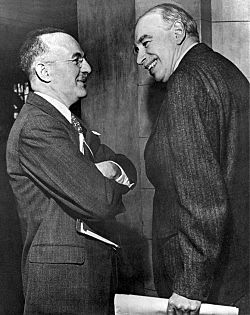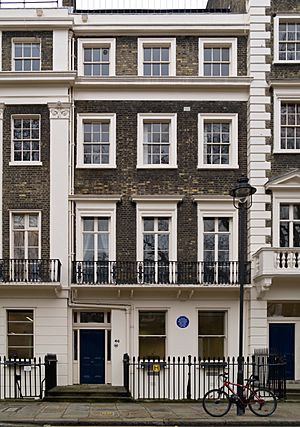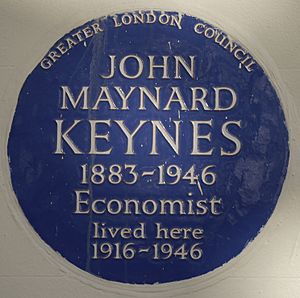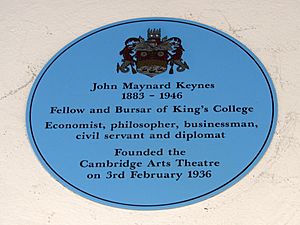John Maynard Keynes facts for kids
Quick facts for kids
John Maynard Keynes
|
|
|---|---|

John Maynard Keynes (right) and Harry Dexter White at the Bretton Woods Conference
|
|
| Born | June 5, 1883 |
| Died | April 21, 1946 (aged 62) Tilton, Sussex, UK
|
| Education | Eton College and King's College, Cambridge |
| Occupation | Economist |
| Spouse(s) | Lydia Lopokova |
| Parent(s) | John Neville Keynes, Florence Ada Brown |
| Signature | |
John Maynard Keynes, 1st Baron Keynes, CB (5 June 1883 – 21 April 1946) was a British economist. His ideas, called Keynesian economics, had a big impact on modern economic and political theory. His ideas also had a big impact on many governments' tax and economic policies. He said governments should use tax and banking measures to stop the effects of economic recessions, depressions and booms. He is one of the fathers of modern theoretical macroeconomics.
The Economist has described Keynes as "Britain's most famous 20th-century economist". In addition to being an economist, Keynes was also a civil servant, a director of the Bank of England, and a part of the Bloomsbury Group of intellectuals.
Contents
Personal life
John Maynard Keynes was born at 7 Melville Road, Cambridge, England. His father was John Neville Keynes, an economics lecturer at Cambridge University. His mother was Florence Ada Brown, a successful author and a social reformer. His younger brother, Geoffrey Keynes (1887–1982) was a surgeon and bibliophile (book lover). His younger sister Margaret (1890–1974) married the Nobel Prize-winning physiologist Archibald Hill.
Keynes first went to King’s College, Cambridge, in 1902. At first he studied mathematics. Later he studied economics under A.C. Pigou and Alfred Marshall. People think Professor Marshall prompted Keynes to change his studies from mathematics and classics to economics. Keynes received his B.A. in 1905 and his M.A. in 1908.
Keynes was a successful investor and he built up a big fortune. He nearly lost all of his money after the Stock Market Crash of 1929. Later he re-built his fortune. He enjoyed collecting books: for example, he collected and protected many of Isaac Newton's papers.
Lord Bertrand Russell said Keynes was the most intelligent person he had ever known. Lord Russell said: "Every time I argued with Keynes, I felt that I took my life in my hands, and I seldom emerged without feeling something of a fool."
Career
Keynes accepted a lectureship at Cambridge in economics funded personally by Alfred Marshall. Soon he was appointed to the Royal Commission on Indian Currency and Finance, where he was able to put economic theory into practice.
During World War I he worked for the Adviser to the Chancellor of the Exchequer and to the Treasury on Financial and Economic Questions.
Keynes also attended the Conference on the Versailles Treaty to end World War I. He wrote The Economic Consequences of the Peace in 1919, and A Revision of the Treaty in 1922. In his books he said that the reparations which Germany was being made to pay would ruin the German economy and would lead to further fighting in Europe. These predictions were shown to be true when the German economy suffered in the hyperinflation of 1923. Reparations were only completed in 2010.
Keynes's magnum opus (Latin for "Great Work", meaning his most famous book) was the General Theory of Employment, Interest and Money. The General Theory was published in 1936. The ideas in that book were very different from classical economics.
Historians agree that Keynes influenced U.S. president Roosevelt's New Deal. Spending more the government earned in taxes (called deficit spending) was used in the New Deal from 1938. But the idea had been agreed to by President Herbert Hoover. Few senior economists in the U.S. agreed with Keynes in the 1930s. With time, however, his ideas became more widely accepted.
In 1942, Keynes was raised to the House of Lords. He became Baron Keynes of Tilton in the County of Sussex. When he sat in the House of Lords he was a Liberal member.
During World War II, Keynes wrote a book titled How to Pay for the War. He said the war effort should be paid for by higher taxes. He did not like deficit spending because he wanted to avoid inflation.
Death
Throughout his life, Keynes worked energetically for the benefit both of the public and his friends; even when his health was poor, he laboured to sort out the finances of his old college. Helping to set up the Bretton Woods system, he worked to institute an international monetary system that would be beneficial for the world economy. In 1946, Keynes suffered a series of heart attacks, which ultimately proved fatal. They began during negotiations for the Anglo-American loan in Savannah, Georgia, where he was trying to secure favourable terms for the United Kingdom from the United States, a process he described as "absolute hell". A few weeks after returning from the United States, Keynes died of a heart attack at Tilton, his farmhouse home near Firle, East Sussex, England, on 21 April 1946, at the age of 62. Against his wishes (he wanted his ashes to be deposited in the crypt at King's), his ashes were scattered on the Downs above Tilton.
Both of Keynes's parents outlived him: his father John Neville Keynes (1852–1949) by three years, and his mother Florence Ada Keynes (1861–1958) by twelve. Keynes's brother Sir Geoffrey Keynes (1887–1982) was a distinguished surgeon, scholar and bibliophile. His nephews include Richard Keynes (1919–2010), a physiologist, and Quentin Keynes (1921–2003), an adventurer and bibliophile.
Personal life

In 1921, Keynes wrote that he had fallen "very much in love" with Lydia Lopokova, a well-known Russian ballerina and one of the stars of Sergei Diaghilev's Ballets Russes. They were married in 1925. The couple hoped to have children but this did not happen.


Support for the arts
Keynes thought that the pursuit of money for its own sake was a pathological condition, and that the proper aim of work is to provide leisure. He wanted shorter working hours and longer holidays for all.
Keynes was interested in literature in general and drama in particular and supported the Cambridge Arts Theatre financially, which allowed the institution to become one of the major British stages outside London.
Keynes's interest in classical opera and dance led him to support the Royal Opera House at Covent Garden and the Ballet Company at Sadler's Wells. During the war, as a member of CEMA (Council for the Encouragement of Music and the Arts), Keynes helped secure government funds to maintain both companies while their venues were shut. Following the war, Keynes was instrumental in establishing the Arts Council of Great Britain and was its founding chairman in 1946. From the start, the two organisations that received the largest grants from the new body were the Royal Opera House and Sadler's Wells.
Keynes built up a substantial collection of fine art, including works by Paul Cézanne, Edgar Degas, Amedeo Modigliani, Georges Braque, Pablo Picasso and Georges Seurat (some of which can now be seen at the Fitzwilliam Museum). He enjoyed collecting books; he collected and protected many of Isaac Newton's papers. In part on the basis of these papers, Keynes wrote of Newton as "the last of the magicians."
Influence and legacy
From the end of the Great Depression to the mid-1970s, Keynes provided the main inspiration for economic policymakers in Europe, America and much of the rest of the world. While economists and policymakers had become increasingly won over to Keynes's way of thinking in the mid and late 1930s, it was only after the outbreak of World War II that governments started to borrow money for spending on a scale sufficient to eliminate unemployment. According to the economist John Kenneth Galbraith (then a US government official charged with controlling inflation), in the rebound of the economy from wartime spending, "one could not have had a better demonstration of the Keynesian ideas".
The Keynesian Revolution was associated with the rise of modern liberalism in the West during the post-war period. Keynesian ideas became so popular that some scholars point to Keynes as representing the ideals of modern liberalism, as Adam Smith represented the ideals of classical liberalism. After the war, Winston Churchill attempted to check the rise of Keynesian policy-making. Despite his popularity as a war hero, Churchill suffered a landslide defeat to Clement Attlee, whose government's economic policy continued to be influenced by Keynes's ideas.
Publications
Books
- 1913 Indian Currency and Finance
- 1919 The Economic Consequences of the Peace
- 1921 A Treatise on Probability
- 1922 Revision of the Treaty
- 1923 A Tract on Monetary Reform
- 1926 The End of Laissez-Faire
- 1930 A Treatise on Money
- 1931 Essays in Persuasion
- 1933 Essays in Biography
- 1936 The General Theory of Employment, Interest and Money
- 1940 How to Pay for the War: A radical plan for the Chancellor of the Exchequer
- 1949 Two Memoirs. Ed. by David Garnett (On Carl Melchior and Keynes' early intellectual interests, including G. E. Moore.)
Images for kids
-
King's College, Cambridge. Keynes's grandmother wrote to him saying that, since he was born in Cambridge, people will expect him to be clever.
-
Keynes's colleague, David Lloyd George. Keynes was initially wary of the "Welsh Wizard," preferring his rival Asquith, but was impressed with Lloyd George at Versailles; this did not prevent Keynes from painting a scathing picture of the then-prime minister in The Economic Consequences of the Peace.
-
The Great Depression and its periods of worldwide economic hardship formed the backdrop against which the Keynesian Revolution took place. This image is Migrant Mother, taken by photographer Dorothea Lange in March 1936.
-
Keynes (right) and the US representative Harry Dexter White at the inaugural meeting of the International Monetary Fund's Board of Governors in Savannah, Georgia in 1946
-
Prime Minister Clement Attlee with King George VI after Attlee won the 1945 election
-
The economist Manmohan Singh, the then prime minister of India, spoke strongly in favour of Keynesian fiscal stimulus at the 2008 G-20 Washington summit.
-
Friedrich Hayek, one of Keynes's most prominent critics
See also
 In Spanish: John Maynard Keynes para niños
In Spanish: John Maynard Keynes para niños













